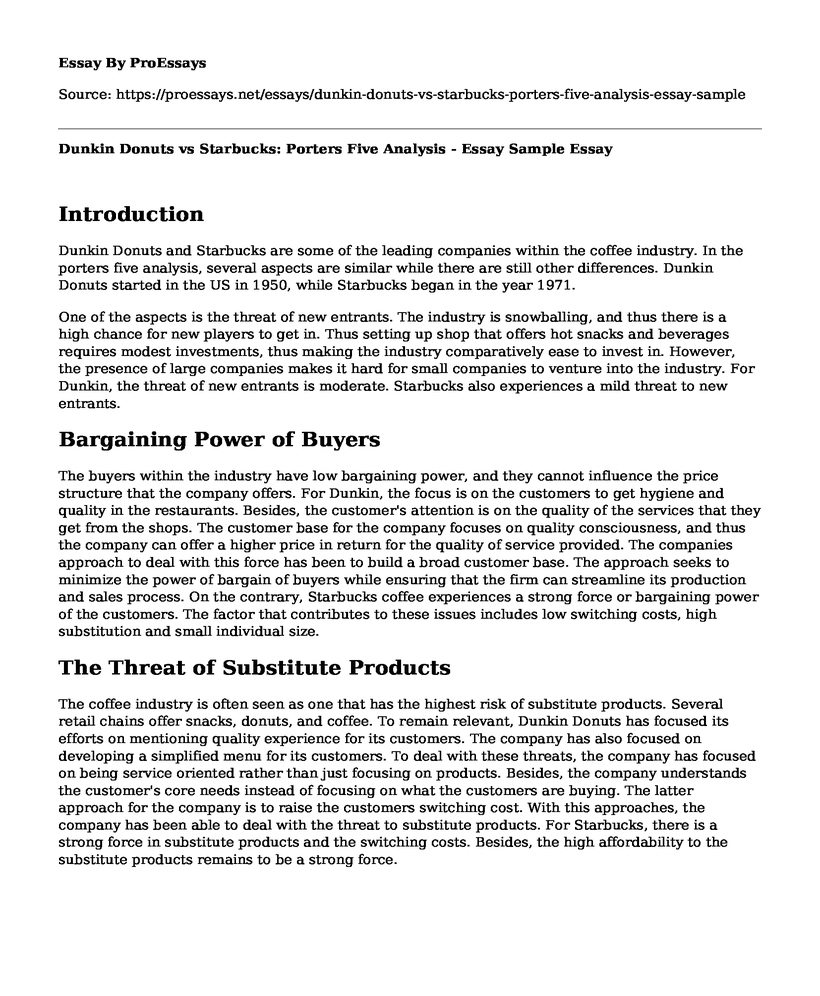Introduction
Dunkin Donuts and Starbucks are some of the leading companies within the coffee industry. In the porters five analysis, several aspects are similar while there are still other differences. Dunkin Donuts started in the US in 1950, while Starbucks began in the year 1971.
One of the aspects is the threat of new entrants. The industry is snowballing, and thus there is a high chance for new players to get in. Thus setting up shop that offers hot snacks and beverages requires modest investments, thus making the industry comparatively ease to invest in. However, the presence of large companies makes it hard for small companies to venture into the industry. For Dunkin, the threat of new entrants is moderate. Starbucks also experiences a mild threat to new entrants.
Bargaining Power of Buyers
The buyers within the industry have low bargaining power, and they cannot influence the price structure that the company offers. For Dunkin, the focus is on the customers to get hygiene and quality in the restaurants. Besides, the customer's attention is on the quality of the services that they get from the shops. The customer base for the company focuses on quality consciousness, and thus the company can offer a higher price in return for the quality of service provided. The companies approach to deal with this force has been to build a broad customer base. The approach seeks to minimize the power of bargain of buyers while ensuring that the firm can streamline its production and sales process. On the contrary, Starbucks coffee experiences a strong force or bargaining power of the customers. The factor that contributes to these issues includes low switching costs, high substitution and small individual size.
The Threat of Substitute Products
The coffee industry is often seen as one that has the highest risk of substitute products. Several retail chains offer snacks, donuts, and coffee. To remain relevant, Dunkin Donuts has focused its efforts on mentioning quality experience for its customers. The company has also focused on developing a simplified menu for its customers. To deal with these threats, the company has focused on being service oriented rather than just focusing on products. Besides, the company understands the customer's core needs instead of focusing on what the customers are buying. The latter approach for the company is to raise the customers switching cost. With this approaches, the company has been able to deal with the threat to substitute products. For Starbucks, there is a strong force in substitute products and the switching costs. Besides, the high affordability to the substitute products remains to be a strong force.
Competitive Rivalry
There is so much competition from the other business that is providing services within the coffee and snack industry. The most significant competitor to Dunkin Donut is Starbucks that offers hot beverages and snacks. For Dunkin doughnuts, their focus has been on buying products in large quantities at a lower price. The approaches have allowed them to service high quality products and a lower price than the competitors. Therefore the two companies are in direct competition. To keep afloat, each company needs to develop strategies to overcome the challenge. For Starbucks, the competition form for other players is a strong force. The company has focused on a generics strategy and intensive growth to deal with the threat that comes from the competitors. The generic differentiation strategy focuses on making the company different from its competitors. The approach also has made the company focus on specialty coffee that is unique to the company. Besides, the company has adopted a sourcing policy that is responsive and sustainable with the focus of differentiating its services and products from competitors.
Bargaining Power of Suppliers
All players in the restaurant industry buy the material for making products from several suppliers. Suppliers that are in a dominant sale position can pose a severe threat to the Dunkin brand and Starbucks. Dominant suppliers would use their power of negotiating to demand higher prices from their customers. To deal with this issues, Dunkin has focused on building a supply chain that is efficient using suppliers. The company has also taken a keen interest in experimenting with product design using various materials. The approach ensures that other products can substitute the rise of prices in the raw material. Starbucks also uses the same method. The company focuses on using many suppliers around the world. Besides, the cost of switching suppliers is not high, and thus the approach helps to reduce the power of bargain of suppliers.
Conclusion
In conclusion, the coffee and snack industry is very competitive. However, Starbucks and Dunkin dugouts are some of the companies that have kept a good share of the market. The approaches that they adopt revolve around quality customer services and using various suppliers. The efforts have ensured the companies keep up with the competition in the industry.
Reference
Kroenke, D. M., & Boyle, R. J. (2015). Using mis. Prentice Hall Press. https://drive.google.com/file/d/1-NTvlTdj5YTdCp1GpxEzTw7YzhCZDjvd/view
Cite this page
Dunkin Donuts vs Starbucks: Porters Five Analysis - Essay Sample. (2023, Mar 03). Retrieved from https://proessays.net/essays/dunkin-donuts-vs-starbucks-porters-five-analysis-essay-sample
If you are the original author of this essay and no longer wish to have it published on the ProEssays website, please click below to request its removal:
- Microsoft Versus Apple - Essay Sample
- Description of Walmart and Overview of Its Systems - Paper Example
- Summary of the History Amazon - Essay Sample
- Apple Quality Management - Essay Sample
- Coca-Cola: Collaborating to Keep Prices Sustainable & Engaging Local Communities - Essay Sample
- Paper Example on Food Deserts: Causes of Nutritional Inequality
- Research Proposal Sample on Nike Advert







